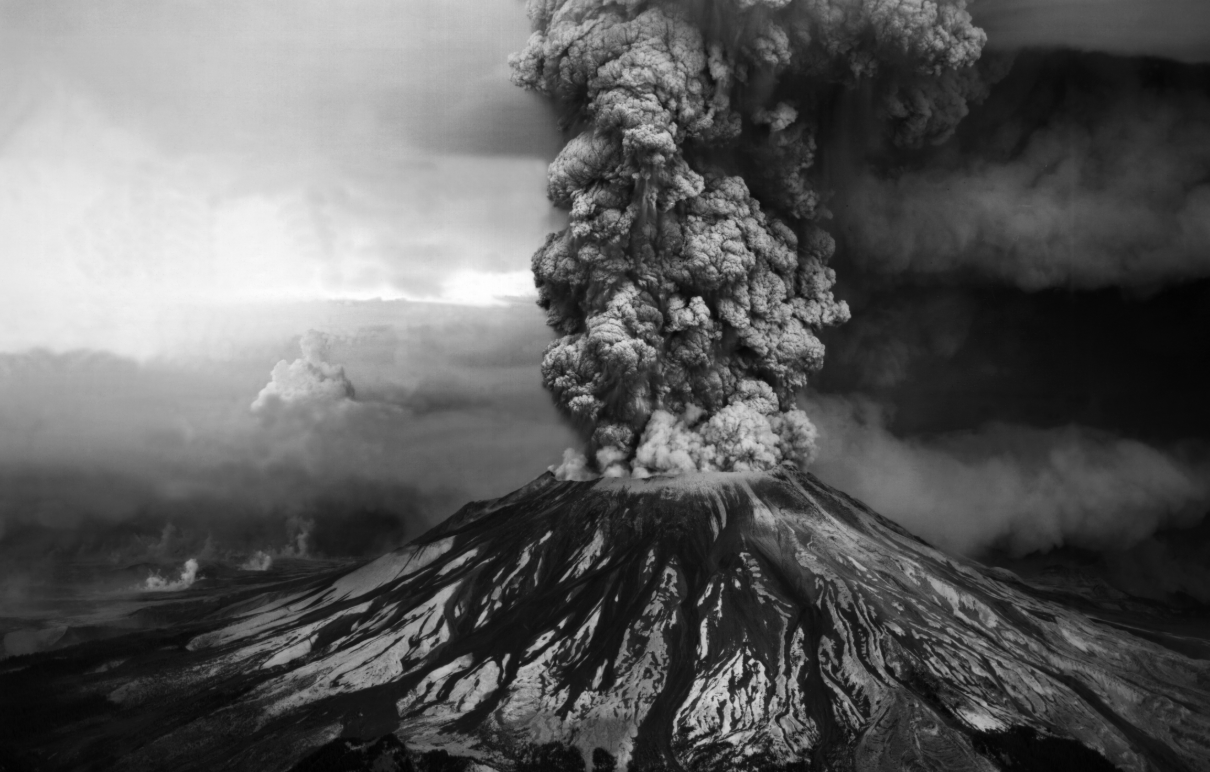
story by Helen Hill for MITGCM

In this story we spotlight an MIT study which uses MITgcm to probe the ocean’s role in mediating the climate’s response to volcanic eruptions.
Large volcanic eruptions are a natural, impulse-like perturbation to the climate system. The sulfur particles ejected into the stratosphere during these eruptions are rapidly converted to sulfate aerosols that diminish the net incoming solar flux at the top of the atmosphere resulting in a cooling of the near-surface climate. The sulfate aerosols have a long residence time (about 1-2 years in the stratosphere) but have been observed to cause surface cooling for many more years after the eruption.
In their paper The climate response to multiple volcanic eruptions mediated by ocean heat uptake: damping processes and accumulation potential now online in the Journal of Climate, graduate student Mukund Gupta working with advisor John Marshall use a hierarchy of models, among them MITgcm (both in the form of a simple slab model and as a fully coupled, spatially resolving GCM) to explore the role of the ocean in mediating the response of the climate to single and serial volcanic eruptions that lead to cold temperature anomalies in the ocean interior, as measured by the ocean heat exchange parameter q.
In this study, the researchers leverage the classic “double-drake” aquaplanet configuration of MITgcm to simulate the physics of an ocean-covered planet coupled to an atmosphere, absent land, sea-ice or clouds. In the “double-drake” two narrow barriers, the depth of the model ocean, set 90° apart extend from the North Pole to 35°S separate the ocean into a large and a small basin connected in a circumpolar region to the south providing geometrical constraints on the circulation. Box models are then used to help in the interpretation of the globally-averaged sea surface temperature (SST) responses of the MITgcm aquaplanet to the idealized volcanic forcings imposed.
The pair finds that the response to a single (Pinatubo-like) eruption comprised two primary timescales, one fast (year) and one slow (decadal).
Over the fast timescale, their experiments suggested that the ocean sequesters eruption-induced cooling anomalies at depth, resulting in a damping of the rate of change of SST relative to that expected if the atmosphere acted alone. They also found that while this effect compromises the ability to constrain atmospheric feedback rates (as measured by the relaxation rate λ), it yields information about the transient climate sensitivity proportional to λ + q with their results suggesting that q can significantly exceed λ in the immediate aftermath of an eruption.
Once shielded from damping to the atmosphere, the effect of the volcanic eruption can persist on longer decadal timescales.
Indeed, the researchers assess the ‘accumulation potential’ of a succession of volcanic eruptions over time. They find that this process could in part explain the observed prolongation of cold surface temperatures experienced during, for example, the Little Ice Age.
To find out more about this work contact Mukund
This Month’s Featured Publication
- Mukund Gupta and John Marshall (2018), The climate response to multiple volcanic eruptions mediated by ocean heat uptake: damping processes and accumulation potential, Journal of Climate, doi: 10.1175/JCLI-D-17-0703.1
Other New Publications this Month
Igor Bashmachnikov, Tatyana Belonenko, Pavel Kuibin, Denis Volkov, Victor Foux (2018), Pattern of vertical velocity in the Lofoten vortex (the Norwegian Sea), Ocean Dynamics, doi: 10.1007/s10236-018-1213-1
O. Bouhali, I.G. Economou, F. El-Mellouhi (2018), Some recent developments on computational science and engineering, Journal of Computational Science, doi: 10.1016/j.jocs.2018.08.006
Sultan Hameed, Christopher L. P. Wolfe, and Lequan Chi (2018), Impact of the Atlantic Meridional Mode on Gulf Stream North Wall Position, Journal of Climate, doi: 10.1175/JCLI-D-18-0098.1
Sudip Jana, Avijit Gangopadhyay, Pierre F.J.Lermusiaux, Arun Chakraborty, Sourav Sil, Patrick J.HaleyJr. (2018), Sensitivity of the Bay of Bengal upper ocean to different winds and river input conditions, Journal of Marine Systems, doi: 10.1016/j.jmarsys.2018.08.001
Sachiko Mohanty, A.D. Rao, G. Latha (2018), Energetics of Semidiurnal Internal Tides in the Andaman Sea, Journal of Geophysical Research – Oceans, doi: 10.1029/2018JC013852
Samah El Mohtar, Ibrahim Hoteit, Omar Knio, Leila Issa, Issam Lakkis (2018), Lagrangian tracking in stochastic fields with application to an ensemble of velocity fields in the Red Sea, Ocean Modeling, Volume 131, November 2018, pp 1- 14, doi: 10.1016/j.ocemod.2018.08.008
Yoshihiro Nakayama, Dimitris Menemenlis, Hong Zhang, Michael Schodlok & Eric Rignot (2018), Origin of Circumpolar Deep Water intruding onto the Amundsen and Bellingshausen Sea continental shelves, Nature Communications, doi: s41467-018-05813-1
Helen R. Pillar, Helen L. Johnson, David P. Marshall, Patrick Heimbach, and So Takao (2018), Impacts of Atmospheric Reanalysis Uncertainty on Atlantic Overturning Estimates at 25°N, Journal of Climate, doi: 10.1175/JCLI-D-18-0241.1
Karina Ramos-Musalem and Susan E. Allen (2018), The impact of locally-enhanced vertical diffusivity on the cross-shelf transport of tracers induced by a submarine canyon, arXiv:1808.07237v1 [physics.ao-ph]
Itzel Ruvalcaba Baroni, Alexandre Pohl, Niels A.G.M. van Helmond, Nina M. Papadomanolaki, Angela L. Coe, Anthony S. Cohen, Bas van de Schootbrugge, Yannick Donnadieu, Caroline P. Slomp (2018), Ocean circulation in the Toarcian (Early Jurassic), a key control on deoxygenation and carbon burial on the European Shelf, Paleoceanography and Paleoclimatology, doi: 10.1029/2018PA003394
Nataliya Stashchuk, Vasiliy Vlasenko, Kerry L. Howell (2018), Modelling tidally induced larval dispersal over Anton Dohrn Seamount, Ocean Dynamics, doi: 10.1007/s10236-018-1206-0
Maria E. Steinrueck, Vivien Parmentier, Adam A. Showman, Joshua D. Lothringer, and Roxana E. Lupu (2018), The Effect of Disequilibrium Carbon Chemistry on the Atmospheric Circulation and Phase Curves of Hot Jupiter HD 189733b, arXiv:1808.02011v1 [astro-ph.EP]
Yohei Takano, Takamitsu Ito, Curtis Deutsch (2018), Projected Centennial Oxygen Trends and Their Attribution to Distinct Ocean Climate Forcings, Global Biogeochemical Cycles, doi: 10.1029/2018GB005939
Jacob O. Wenegrat and Leif N. Thomas (2018), Effects of the Submesoscale on the Potential Vorticity Budget of Ocean Mode Waters, Journal of Physical, doi: 10.1175/JPO-D-17-0219.1
Xi Zhang and Adam P. Showman (2018), Global-Mean Vertical Tracer Mixing in Planetary Atmospheres II: Tidally Locked Planets, arXiv:1808.05365v1 [astro-ph.EP]
Xia Zhao, Dongliang Yuan, Guang Yang, Jing Wang, Hailong Liu, Renhe Zhang, Weiqing Han (2018), Interannual variability and dynamics of intraseasonal wind rectification in the equatorial Pacific Ocean, Climate Dynamics, doi: 10.1007/s00382-018-4383-0
Yanan Zhu, Bo Qiu, Xiaopei Lin, Fan Wang (2018), Interannual Eddy Kinetic Energy Modulations in the Agulhas Return Current, Journal of Geophysical Research – Oceans, doi: 10.1029/2018JC014333
Do you have news about research using MITgcm? We are looking for contributions to these pages. If you have an interesting MITgcm project (ocean, atmosphere, sea-ice, physics, biology or otherwise) that you want to tell people about, get in touch. To make a post, contact Helen

